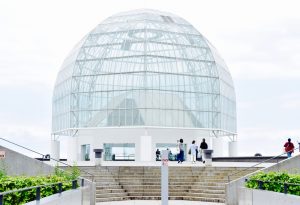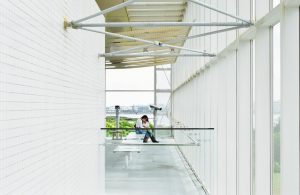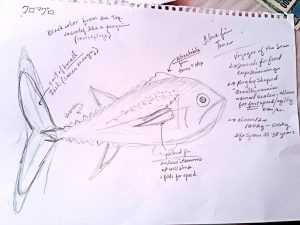Oh man. Where do I even begin. There’s so much I want to say about today. Put simply, it was absolutely incredible. Even the title of this post I had a lot of trouble deciding. I ended up settling on this modified lyric from “Age of Aquarius” by 5th Dimension. If you haven’t guessed already, we visited an aquarium, Tokyo Sea Life Park. And as I think you’ll see in this post, I think now more than ever, amidst an ever-changing world filled with climate change, habitat destruction, and biodiversity loss, it’s imperative that we inspire care for animal life and conservation in people. And that’s where aquariums come in.
I guess maybe the best place to start is a little context. Last night, I read several chapters (15-18, 23) from A Fascination for Fish by David C. Powell. Powell is an aquarium design consultant and has worked with numerous aquariums around the world, notably Monterrey Bay Aquarium. The chapters I read dealt with the inception of Monterrey Bay Aquarium: from designing exhibits to collecting animals to aquarists at work. Chapter 23, the last chapter, served as a reflection on Powell’s experiences with aquariums and his thoughts on aquariums and their purpose. I’ll get to that in a little bit. I mentioned this to Selinger-sensei on the way to Tokyo Sea Life Park, but I thought it was a very publicly-accessible reading, in contrast to “Ciliated Sense,” which I discussed in a previous post. To be honest, it made me seriously consider the possibility of becoming an aquarist. One thing that really struck me about this reading was Powell’s description of aquarists. It’s not just about “feeding the fish”; yes, that’s involved and knowing the specialized feeding needs (something I can kind of relate to being a vegetarian in Japan) of different species is incredibly important. It goes beyond that to having a fascination with the animals you’re working with and being able to “read” them; that is, being able to tell just by looking what a particular animal needs.
~~~
We began with a walk-through of Tokyo Sea Life Park, perhaps on the surface no different than the other tourists and local aquarium-goers. I’m going to be completely honest here: I was worried my peers and friends wouldn’t get all that much out of just walking through the aquarium. I love learning about animals, especially marine organisms, so visiting zoos and aquariums for me is more than just marveling at the animals. But, based on everyone’s reactions to the Ueno Zoo the other day (notably, after the panda exhibit), I was worried everyone wouldn’t be too interested. Maybe it was just being outside in the sun.
I was absolutely wrong. Something about the aquarium captured the interest of everyone, and I found myself explaining what marine biology of the animals I knew alongside Michael (we spent a solid 5, 10 minutes in front of the hammerhead exhibit, the very first one of the aquarium). I don’t know if I really expressed this to anyone during the day, or if I’ll even be able to capture the feeling in words here, but I was just so relieved and thrilled that everyone was taking so much interest. Last night, I was talking with Aridome-sensei about how much time I thought we’d need in the aquarium (at the time, I didn’t know how big or small it was; turns out it’s about the size of Maritime Aquarium). I realized during lunch that we probably could’ve spent more time at the aquarium, frankly. Oh well, all the more excuse to come back, right?
~~~
The highlight of the trip for me, though, was our meeting with Tada-sensei, head curator at Tokyo Sea Life Park. I’d corresponded (through Aridome-sensei; 多い質問をほんやくしてくださってありがとうございました!) with Tada-sensei prior over email, so he’d be able to prepare himself with the questions I’d sent him beforehand. But first, he gave us an educational program on bluefin tuna (クロマグロ; kuro maguro) that the aquarium designed for elementary and middle schoolers. He surprised us all by handing us sketchbooks and pencils and taking us to the tuna exhibit. He wanted us to get a feel for the observation and attention to detail needed in his line of work and in biology in general. He gave us 5 minutes to sketch tuna as they swam by, and then talked to us about many of the adaptive features of tuna. He even took us behind the scenes, above the tuna exhibit, to show us firsthand how countershading works (basically, many marine species are dark colored on their dorsally and light-colored ventrally. When seen from above, tuna are hard to see because they blend in with the dark, deep water. When seen from below, their light coloration lets them blend in with the sunlight streaming down). I was actually able to pick up on a lot of what he was saying in Japanese, through a combination of language and my own knowledge of marine biology, so it was really cool to be able to help with translating those elements! Finally, he took us back to the presentation room and brought out a dead, frozen tuna for us to explore by touch.
Following that, Tada-sensei began to answer the 9 questions I had posed to him via email as well as other questions we thought of on the spot. I’ll probably include those in a separate post, for sake of flow and length here, but a lot of what he talked about echoed ideas I had read about in Powell’s A Fascination for Fish. It was fascinating to see and hear parallels between Monterrey Bay Aquarium and Tokyo Sea Life Park. Selinger-sensei later told me that Tada-sensei thought I had raised really important questions and that some in particular (especially my question on the ethical capture and keeping of animals in captivity) were incredibly difficult to answer. Selinger-sensei assured him that these questions weren’t meant to be severe or critical in nature, but rather since I, myself, am considering aquariums as a potential career path, these are the very questions I am asking myself. And, she told me, Tada-sensei said that he could really pick up on my enthusiasm and fascination (incidentally, he’d extended the original hour and a half meeting to two hours).
What struck me most, though, about Tada-sensei’s talk was how honest, sincere, comprehensive, informative, and engaging it was. In particular, I was moved by Tada-sensei’s own emotional investment in his work, that he thinks education and inspiring awe and conservation (echoed also by Powell in chapter 23) is by far the most important of the aquarium’s goals. I recall a particularly relevant, though long, passage (though, there’s many and it’s hard to pick) from A Fascination for Fish that I think is at the core of aquariums and their mission:
We may have only one chance to turn a visitor’s head toward conservation and conscience and away from complacency–a chance that is offered through our exhibits. For an exhibit and a visitor to make a connection, those of us designing displays and defining messages must be cautious.
Do we assume the visitor knows nothing and it’s our obligation to explain as much as we can? At one time, I would have answered yes to that question. My original goal was to bring as much factual understanding as possible to the visitor, to describe every detail of a creature’s existence, from feeding to spawning to its relationship with the other creatures in its environment. And I expected the visitor to absorb all this eagerly.
Now I see things quite differently. I’ve come to realize that perhaps our true goal in the aquarium world is to inspire awe, to create a sense of wonder and appreciation that will grow into caring. Communicating facts is all well and good, but without a sense of caring we have accomplished little.
David C. Powell, A Fascination for Fish
Put simply, these ideas resonated strongly with me.
And, Tada-sensei was extremely honest in admitting that Tokyo Sea Life Park’s exhibits aren’t enough, he thinks, for its inhabitants, especially size-wise. Still, I thought the exhibits quite well replicated the natural environments they were portraying, even if they were small and cramped as Tada-sensei thought. Tada-sensei also apparently has been to Monterrey Bay Aquarium and thinks it’s the best in the world and uses that as something of a role model or exemplar. Talking with Tada-sensei I think solidified the sense I had gotten from reading A Fascination for Fish; that is, I think becoming an aquarist is something I really want to pursue. But, I think something else that resonated with me about reading about Powell’s experience with Monterrey Bay Aquarium, visiting Tokyo Sea Life Park, and talking with Tada-sensei is that there’s still so much to learn about this marine and aquarium world. And I want to leave you with a passage from Powell’s last chapter that I think was really inspirational for me and hopefully for you, the reader, and for anyone reading A Fascination for Fish interested in marine biology and aquariums:
When meeting young, eager marine biologists, I do my best to steer them in a direction that will give them as much satisfaction as I’ve had in my work. When they ask what they can do to get started, I pass along commonsense tips: Get an education. Learn to dive, so you can experience the underwater world firsthand. Volunteer if you can. Keep learning, diving, and working with the animals you love.
David C. Powell, A Fascination for Fish
So, will I become an aquarist in the future? Perhaps. I’m excited to intern at Maritime Aquarium this summer (an Education internship; Animal Husbandry was rather popular and full) and experience this aquarium world on the other side firsthand. I plan to follow Powell’s advice and see where it takes me. So, stay tuna’d.




